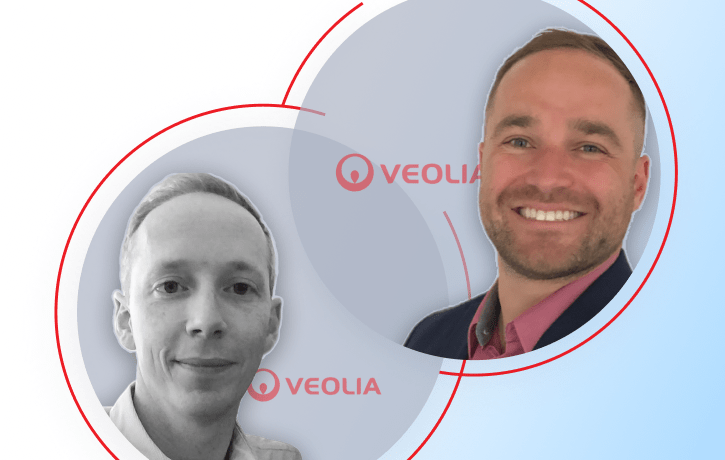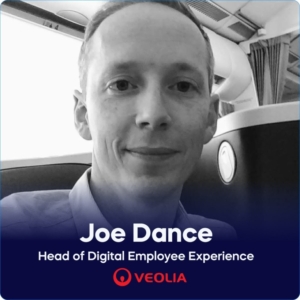Veolia’s Head of Digital Employee Experience, Joe Dance, and Digital Adoption Manager, Jake Soltysik, detail how they utilize WalkMe’s Digital Adoption Platform (DAP) to streamline change management programs, improve employee experience, and drive business results.
We recently caught up with Veolia’s Joe Dance and Jake Soltysik to discuss their digital adoption program and how they’re working to build a digital adoption center of excellence (CoE) to help employees utilize their software more efficiently to increase impact.
Veolia is the benchmark for ecological transformation. Worldwide, the company designs game-changing solutions that are both useful and practical for water, waste, and energy management. In 2022, these innovations provided 111 million inhabitants with drinking water and 97 million with sanitation, produced 44 terawatt hours of energy, and recovered 61 million tonnes of waste.
In the UK, Veolia has implemented WalkMe’s DAP on over 40 applications, helping to streamline the adoption process for more than 5,000 office employees and 7,000 frontline operatives.
The evolving dynamics of employee experience
Why did you choose to onboard a Digital Adoption Platform (DAP)? What challenges were you trying to overcome?
|
|
Joe Dance: As Head of Digital Employee Experience, my responsibilities include overseeing our suite of applications, including ServiceNow, AppSheet, the entire Google suite, as well as WalkMe, to improve the employee digital experience. Veolia recently underwent a major digital transformation initiative called Veolia “Digital New Age” (DNA), which involved the rollout of more than 20 new digital tools. |
We needed to facilitate the change management program, including user adoption, while ensuring that processes were completed accurately and efficiently.
We also wanted to transition from traditional software training, which involved delivering classroom instruction at more than 100 physical sites. We wanted to improve retention and overcome a constant need for relearning because processes and systems are continually evolving.
Using DAP, we are able to provide contextual learning for new and existing employees, essentially addressing issues before they arise. We’ve noticed that this can be particularly helpful with new employees, who often want to learn about an application on their own.
Jake Soltysik: With WalkMe, we are able to quantify errors, understand how long processes take, and set benchmarks to improve adoption. We’ve also been able to build cross-application smart walkthroughs within WalkMe that automatically copies data from one platform and pastes it to another using WalkMe automation – this has really helped drive data quality and improve employee experience.
Driving business outcomes with customized employee experiences
How have you been able to customize WalkMe to meet your specific needs at Veolia?
Jake Soltysik: DAP gave us the ability to segment and localize the content employees see, based on their roles, locations, and languages, which adds another level of granularity when training them on new apps or processes. This was clearly seen when using Workday, a software that uses a lot of American English when describing certain processes, which often confused our UK employees.
We developed “Veolia-ized” contextual guidance that used terms our employees are familiar with, enabling users to clearly understand app features and successfully navigate where they needed to go, without getting frustrated, abandoning processes, or reaching out for help.
Crafting an effective employee experience strategy
How do you go about implementing your digital adoption program? How did you structure your team?
|
|
Jake Soltysik: Our team sits within the Digital Employee Experience department that Joe leads. I manage our digital adoption team, where we’ve developed a Center of Excellence for WalkMe. Other team members include two digital adoption specialists and four team members embedded within our product teams who were certified by WalkMe’s Digital Adoption Institute (DAI). |
Their knowledge of the app and digital adoption best practices makes it easier to build more intuitive app-specific content. We also have eight other team members ready to get trained at the DAI in the coming months.
What role has WalkMe playing in Veolia’s digital transformation strategy?
Jake Soltysik: Since onboarding WalkMe, we estimate that we’ve saved more than 11,000 productivity hours through automation and 10,800 support hours over a 12 month period. In addition, there have been more than 5 million interactions with WalkMe content.
As we’ve developed our digital adoption program, we’ve seen what works and what doesn’t. For example, ShoutOuts have been very effective at communicating specific points, while automations in apps like Workday and GSuite have been huge time savers. Additionally, we can see what people search for and identify where we might need to develop additional in-app guidance to proactively mitigate any support tickets and improve the employee experience.
Measuring and improving employee experience
What are your goals when it comes to boosting employee experience at Veolia?
Jake Soltysik: Going forward, our goal is to continue making WalkMe as intuitive as possible so that employees can seamlessly navigate through multiple applications without getting lost or needing to submit a support ticket. We want to make it so employees don’t need to know which apps do what; they just need to know what they want to do – like book annual leave – and then can use WalkMe to initiate and complete any process.
If we can teach our employees how to use WalkMe from any system, using the menu to type in, search, or click on what action they’d like to take, we don’t need to teach them how to use a new HR system, a new expense system, and so on.
The more we fine-tune WalkMe on our systems, the more engaged employees get, helping boost adoption and engagement. Additionally, as we constantly look to improve and deepen our digital adoption program, we’re keen to deploy WalkMe Workstation, which will give employees one unified launchpad for starting their work, from any device. We want to simplify as much as possible, so our employees – no matter their role or location – can focus on high-impact work.



